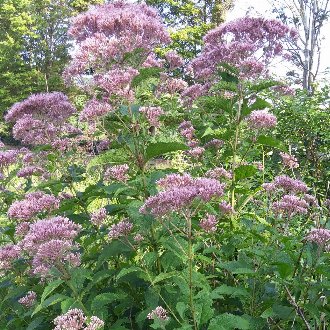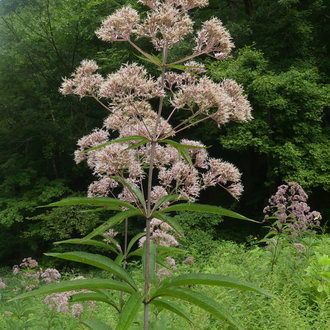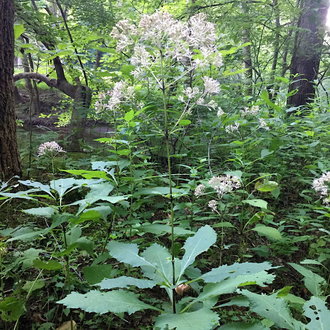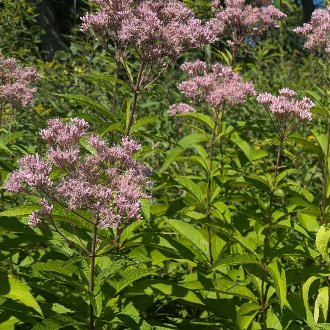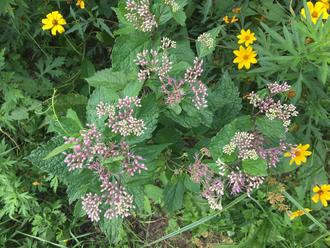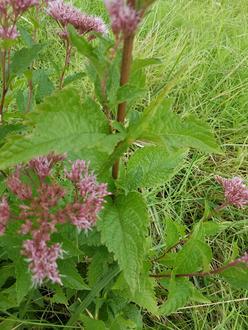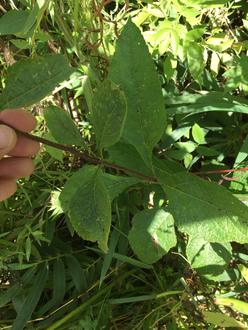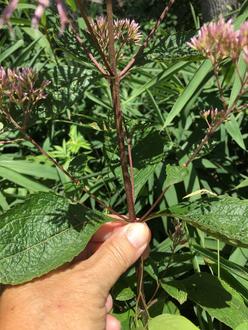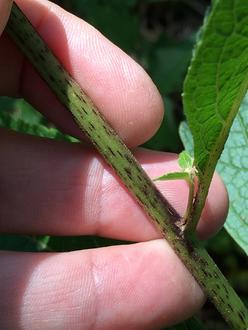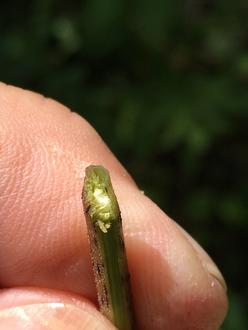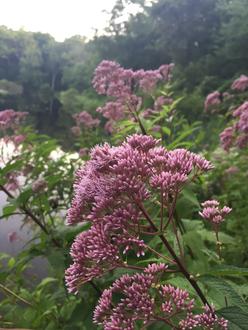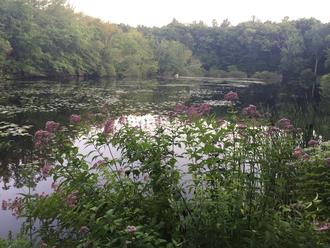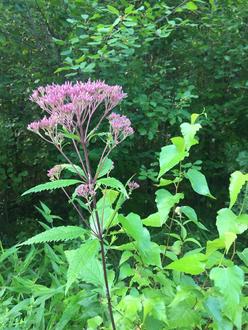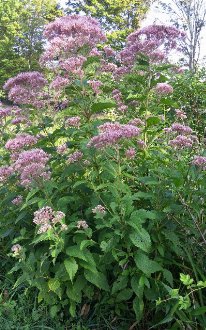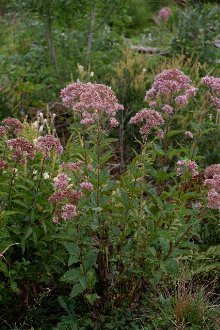Coastal Plain Joe Pye Weed (Eutrochium dubium (Willd. ex Poir.) E.E. Lamont)
Also classified as Eupatoriadelphus dubius (Willd. ex Poir.) R.M.King & H.Rob., Eupatorium dubium Willd. ex Poir.
↑Summary
A perennial of moist, sandy, acidic soils native to the coastal plain from New England south through South Carolina.
↑Description & Identification
E. dubium shares certain characteristics in common with other Eutrochium species, including being a normally unbranched perennial with multiple stems from a short-rhizomatous rootstock, having whorled or rarely opposite leaves, and a pinkish-to-purple inflorescence.
E. dubium is distinguished from other Eutrochium species primarily by its triple-veined leaves and smaller max height; other features can be used to distinguish between other, specific species.
↑Similar Plants
↑Habitat
Found in a variety of wet, acidic habitats, mostly in or near the coastal plain. Habitats include bogs, marshes, swales, low-lying areas along shores of lakes, rivers, and tidal estuaries, wet meadows, pocosins, damp thickets, swamps, and gaps in bottomland forests. Somewhat less common than other Eutrochium in anthropogenic habitats, but occasionally can be found in roadside ditches, wet spots in fallow fields, and suburban gardens where it can both be planted and spread on its own, often thriving in mulch beds.
Found on moist, acidic soils rich in organic matter, usually in sandy soil or sandy muck, but sometimes in other soil textures. Can tolerate soils with some gravel and clay. Tolerates some salinity and temporary periods of drought. Usually found in sunny-to-mostly-sunny habitats, but can sometimes occur in partly-shaded habitats so long as it gets some direct sunlight.
In more inland regions, including the innermost portions of the coastal plain, this species tends to be found mostly around margins of bogs, small ponds, and other wetlands with standing water, as rivers and streams tend to bring mineral-rich water and deposit rich alluvial soils that are too high in pH for this species; in these habitats it is usually replaced by E. fistulosum. Deeper into the coastal plain, this species can be found along rivers, especially as they become estuaries. Similarly, farther inland, this species is not usually found in forests, and it is replaced by E. purpureum in forested habitats, but deep in the coastal plain, where terrain is flatter, this species occurs in swamps and gaps in bottomland woods.
This species is less shade-tolerant than E. purpureum but more so than E. maculatum and E. fistulosum. It has the strongest preference for acidic soils of its genus, and the greatest salt-tolerance. All Eutrochium species rely on some level of disturbance to establish, but this species prefers less disturbance than E. fistulosum and probably less than E. maculatum. It can be found temporarily in richer habitats, but is mostly found in habitats where factors like water level, salinity, and/or soil acidity inhibit the growth of other vegetation. It is more drought-tolerant than E. maculatum and E. fistulosum but not as drought-tolerant as E. purpureum.
↑Life Cycle
This species is a rhizomatous perennial.
Seedlings typically germinate mid-spring, following a period of cold dormancy. Seedlings establish best on sites where some disturbance has exposed soil and temporarily removed competition from ground-level vegetation. In their first year, plants usually do not reach their maximum height. First-year plants may flower but usually do not do so profusely.
On favorable sites, this species will spread by rhizomes and send up more stems each year. Rhizomes usually proceed far enough away that the species forms the appearance of a clonal colony rather than a dense clump, but new stems are usually within a foot of the parent plant. Second-year stems, including from rhizomes, usually reach their maximum height and the plant proceeds to expand horizontally from this point. Already-established plants are better able to handle competition from other vegetation.
Flowers form in mid summer, with seed maturing in autumn. Seeds are wind-distributed.
It is not known whether or not this species forms a persistent seed bank. Some species in the Eupatorieae tribe do, and others do not.
We could not find any information on this species lifespan in the wild. Individuals can persist long-term when site conditions remain ideal. Established plants can be killed by changing water levels leading a site to become too dry or wet, or too saline in areas along estuaries. Plants that established on better-drained sites following a disturbance can eventually die when shaded out by trees or taller vegetation. This same process can happen more slowly on wetland sites as enough organic matter and soil accumulates to support denser tree growth.
↑Faunal Associations
We could not find much on what insects are supported by this plant specifically. The flowers attract a wide variety of pollinators; relative to other Eutrochium species, the scent of the flowers is less floral and slightly more meat-like, leading this species to attract relatively more flies than other species.
Foliage is low in palatability to deer and other mammalian herbivores, but deer will browse the foliage to a degree, especially new spring growth.
Seeds are eaten by birds, and dry seed clusters are sometimes also used as nesting material for birds.
↑Uses
Widely used as an ornamental plant in gardens and landscaping, where it is valued for its tolerance of wet and poorly-drained conditions, and generally being easy to grow on any site with sufficient moisture. In gardens, where competing vegetation is kept away, this species can be grown on more mineral-rich soils than it would occur on in the wild.
Several cultivars exist, the best-known of which are 'Little Joe' and 'Baby Joe'. These and most other cultivars have been selected to have a shorter maximum height even in rich soils, and better tolerance of typical garden conditions, including greater drought tolerance. However, they are less adapted to life in the wild and thus will not contribute as much to supporting vigorous wild populations.
In order to maximize the positive effect of your plantings on nearby ecosystems, we recommend avoiding these cultivars and instead growing plants derived from local wild populations in your area. This will ensure that your plantings help to support and sustain wild populations of this plant, when the seeds from your garden blow into suitable habitat.
↑Related Plants
This species has a small area of overlap with three other native Eutrochium species, mostly in the north of its range, and to a more limited degree moving south. All of these species extend farther inland to the west than this one.
In general, most Eutrochium species hybridize readily, with hybrids occasionally in the wild and even more common in landscaping plants. However, we did not find any records of hybrids involving this species specifically.
↑Links & External Resources
• Eutrochium dubium (Coastal Plain Joe Pye Weed) | USDA PLANTS Database (About This Site)
• Eutrochium dubium | Go Botany (About This Site)
• Coastal Plain Joe-Pye Weed | iNaturalist (About This Site)
• Eutrochium dubium (Coastal Plain Joe Pye Weed) | Missouri Botanical Garden Plant Finder (About This Site)
• Eutrochium dubium | Biota of North America Project (BONAP) (About This Site)
• Eutrochium dubium (Willd. ex Poir.) E.E.Lamont | Plants of the World Online (POWO) (About This Site)
• Eupatorium dubium | NatureServe Explorer (About This Site)
• Eutrochium dubium | Flora of North America (About This Site)
• Coastal Plain Joe Pye Weed | Maryland Biodiversity Project (About This Site)
• Eutrochium dubium (Willd. ex Poir.) E.E. Lamont (Three-nerved Joe-pye-weed) | Digital Atlas of the Virginia Flora (About This Site)



